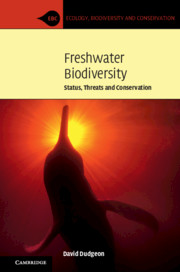Book contents
- Freshwater Biodiversity
- Ecology, Biodiversity and Conservation
- Freshwater Biodiversity
- Copyright page
- Epigraph
- Contents
- Foreword
- Permissions for Epigraphs
- 1 The Freshwater Commons
- 2 Global Endangerment of Freshwater Biodiversity
- 3 Overexploitation
- 4 Alien Species and Their Effects
- 5 River Regulation
- 6 Vanishing Lakes and Threats to Lacustrine Biodiversity
- 7 How Will Climate Change Affect Freshwater Biodiversity?
- 8 Ecosystem Services and Incentivizing Conservation of Freshwater Biodiversity
- 9 Conservation of Freshwater Biodiversity
- Afterword
- References
- Species Index
- General Index
- Plate Section (PDF Only)
6 - Vanishing Lakes and Threats to Lacustrine Biodiversity
Published online by Cambridge University Press: 16 June 2020
- Freshwater Biodiversity
- Ecology, Biodiversity and Conservation
- Freshwater Biodiversity
- Copyright page
- Epigraph
- Contents
- Foreword
- Permissions for Epigraphs
- 1 The Freshwater Commons
- 2 Global Endangerment of Freshwater Biodiversity
- 3 Overexploitation
- 4 Alien Species and Their Effects
- 5 River Regulation
- 6 Vanishing Lakes and Threats to Lacustrine Biodiversity
- 7 How Will Climate Change Affect Freshwater Biodiversity?
- 8 Ecosystem Services and Incentivizing Conservation of Freshwater Biodiversity
- 9 Conservation of Freshwater Biodiversity
- Afterword
- References
- Species Index
- General Index
- Plate Section (PDF Only)
Summary
Anthropogenic alteration of river flows, lake levels, and the duration and extent of wetland inundation – collectively, flow regulation – degrades habitats, with manifold direct and indirect effects on populations, community structure and food webs. These can arise from an overall insufficiency of water, or changes in flow that result in there being too much or too little water at particular times.Fluxes of sediments and nutrients are also affected by trapping in dams, while water released downstream may have altered temperature, flow magnitude or periodicity, and erosive power.To mitigate such effects in rivers and associated wetlands, it is essential to allocate sufficient water as an environmental flow (e-flow) in order to sustain native biodiversity and ecosystem functioning.There is general consensus that this allocation should involve sufficient water to mimic the natural flow regime.Obstruction of movement of materials and migrations by animals (mainly fishes) by dams will require different and innovative solutions, and the proliferation of hydropower dams on large rivers (Amazon, Mekong) will have serious consequences for ecology and fishery yields.
Keywords
- Type
- Chapter
- Information
- Freshwater BiodiversityStatus, Threats and Conservation, pp. 259 - 290Publisher: Cambridge University PressPrint publication year: 2020

